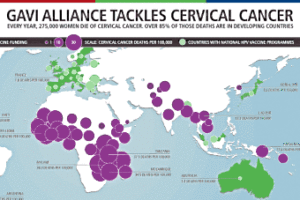This is the second of two posts adapted from remarks by Ngozi Okonjo-Iweala on technology’s value in advancing global development. She spoke recently at the Aspen Institute in collaboration with the annual Brookings Blum Roundtable on Global Poverty.
Chair of Geneva-based Gavi, the Vaccine Alliance, Dr. Okonjo-Iweala describes three more cases of how the fight against poverty is sparking technology innovation.
 In many parts of the world, large numbers of women are unable to take control of their finances because they lack the basic documentation to open a bank account.
In many parts of the world, large numbers of women are unable to take control of their finances because they lack the basic documentation to open a bank account.
Globally, 42 percent of adult women do not have a bank account. According to the 2014 Global Findex study, the ratio in sub-Saharan Africa is much worse, at 70 percent. That’s more than one billion people!
Fintech revolution. Providing women with a digital identity helps address the gross inequity of no access to banking services. I am also convinced that the combination of biometrics, mobile phones, and digital payment platforms, when properly applied, can truly empower women and girls.
This revolution in financial technology for consumers can set them up to create wealth and jobs, well beyond speeding them away from poverty.
Look at what is happening with Safaricom M-Pesa, now used by 96 percent of Kenya’s households. A recent study by Georgetown and MIT professors showed that M-Pesa helped an estimated 185,000 Kenyan women move from subsistence farming to entrepreneurial activities, lifting their families out of poverty.
Just this May, I visited women of the Self Employed Women’s Association (SEWA) in Ahmedabad, in western India. Leaders of this historic movement told me many members use money transfers through M-Pesa to run their businesses.
This trans-India network of many co-operatives has 2.5 million members, more than tripling in scale since 2004. Supported by the World Bank, and many others, SEWA has roots in workers’ rights ideas advocated by Mahatma Gandhi a hundred years ago to improve the lives of poor, exploited textile workers.
Low-cost HPV vaccines. Another technology I care deeply about is the HPV vaccine for girls that prevents cervical cancer. A horrific disease, cervical cancer kills 266,000 women every year, wrenching them away in their most productive years from families and communities. Beyond the cancer victims themselves, everyone near them suffers loss.
The vast majority of these deaths – 85 percent – are in developing countries where screening and treatment for the disease – human papillomavirus — are unavailable, or costs for screening and treatment are too high.
If unchecked, the annual number of cervical cancer deaths globally is expected to exceed maternal deaths by 2035, rising to more than 400,000.

Our hope at Gavi is to prevent that tragedy. Gavi is an international partnership supported since 2000 with long-term funds pledged by governments, corporations, individuals, non-profits and philanthropy. Our business model helps establish stable markets for vaccines by pooling demand within countries to reduce costs.
We have the knowhow. Just two shots of the HPV vaccine provides protection against the virus responsible for the vast majority of cervical cancer cases. Four years ago, Gavi took steps to make the HPV vaccine available to the poorest countries at just $4.50 per shot, compared with more than $100 per shot in the U.S.
Governments in these poor countries – 28, and counting — understand how devastating cervical cancer is for individuals, families, and communities. Their response has been unprecedented.
Schoolgirls in the top photo are among 13,000 in Laos who were among the first to receive the HPV vaccine. In all, one million girls so far have been vaccinated. We estimate this work has saved more than two thousand lives. Our ambitious goal over the next few years is to vaccinate 40 million girls and save 90,000 lives.
Immunization sessions targeting HPV vaccines have turned out to be an entirely new way for reaching adolescent girls with other health services. Why?
Because HPV vaccination is most effective for girls who have not yet been exposed to the virus, they must be vaccinated before becoming sexually active. Ideally, this happens between the ages of nine and 13. (Most childhood vaccines mainly are given to infants.)
During these HPV vaccination sessions, health care workers can deliver other services, such as reproductive education, menstrual hygiene, de-worming, nutrition checks, vitamin shots and general check-ups.
Drones. Originally developed for military applications, then fancied by hobbyists, drones today are delivering medical supplies, such as vaccines and donated blood, to rural areas amongst the many hills and mountains of Rwanda. It’s the world’s first autonomous drone delivery service, launched in 2016 by the Rwandan government.
The drones were developed by U.S. startup Zipline, of Half Moon Bay, Calif. Funding and logistics support and medical expertise for the Rwanda project came from UPS and Gavi, respectively. The drones can fly up to 93 miles, at speeds of 60 miles per hour, night or day, in any kind of weather. They can carry 3.3 pounds of blood, enough to save a person’s life. Hemorrhaging after giving birth is the leading cause of death for pregnant women in Rwanda.
The story of drones and development is just beginning. New drone companies are springing up, developing more sophisticated technology for humanitarian applications. Their teams are among legions of innovators setting the stage for quantum leaps in our capacity to reach people in remote communities with life-saving assistance.
**
These three examples just scratch the surface. For more evidence of innovation in global development, look at breakthroughs in biotechnology, food technology, agriculture, rapid diagnostics and other fields. Those campaigns also advance our ability to help solve the big challenges: improving health, equity and inclusiveness, creating wealth and eradicating poverty.
As Nelson Mandela once put it, “Poverty is not an accident. Like slavery and apartheid, it is man-made and can be removed by the actions of human beings.” How appropriate then, to apply a man-made solution, technology, to solve man-made problems.
** ** **
To read more on Zipline drones in Rwanda, see these MIT Technology Review and Trucks.com reports.
To learn more about effectiveness of HPV vaccine immunizations in the U.S., see this New York Times report.
Go here to see the Aspen Institute video of Dr. Okonjo-Iweala’s 2017 Madeleine K. Albright Lecture.
Photo credits: WHO2013/C. McNab (Laotian girls); Gavi (Dr. Okonjo-Iweala, world map).


Leave a Reply